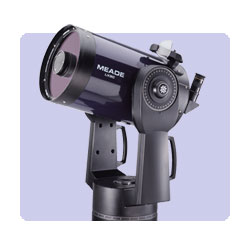
EQUIPMENT
Telescopes:

2005
All my observing and astrophotography was initially carried out with the telescope pictured on my homepage. It is a Meade LX90 (as illustrated above, only without the LNTTM viewfinder) 8" Schmidt-Cassegrain f10 reflector on a motorised alt-azimuthal mount with Goto computer controls (Autostar). I was later to obtain the Meade Wedge mount and tripod plate for setting the telescope in equatorial mode to eliminate field rotation. (see Accessories)
2006
The original 7x50 viewfinder which came with the telescope was replaced by a superior 7x50 viewfinder fitted with a rectifying diagonal and removable, cross-haired 1¼" eyepiece, made by BC&F and bought through SkyViewOptics.
August 2007
Later this month - following the poor performance of the terrestrial 70-300mm zoom Nikkor lens I was using, with regard to chromatic aberration and difficulties focussing, I purchased a William-Optics ZS66 SD Apo doublet refractor, pictured below:
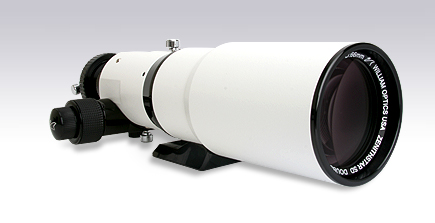
I have mounted it on my LX90 using tube rings made by a small American company called ADM, purchased from Rother Valley Optics . The first result of this configuration may be seen in my picture of M31 on the widefield page.
Cameras:
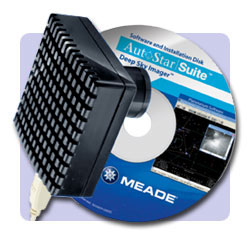
2005
This is the camera which made astrophotography possible for someone with no knowledge of expensive, sophisticated SLR cameras and the technical complexities of low light, long-exposure photography, like myself. The Meade DSI (Deep Sky Imager) is revolutionary in its ease of use, and above all, it's affordability. Its price is a tenth of the normal cost of astronomical CCD cameras, such as those made by the Santa Barbara Instruments Group (SBIG). My only criticism of it is that the manual, both tree-ware and on-line, describes only a fraction of the camera's technical specifications, some of which are required for use with astrophotography software. More about this elsewhere on the site.
My requirements soon exceeded the capabilities of this 640x480 pixel camera and as you can see below, since 2007, all my pictures have been taken with another camera. I now use the Meade DSI purely as an autoguider which it does brilliantly with the packaged software.
March 2007
I have purchased a digital SLR to try and obtain wider-field views than can be achieved with the Meade DSI, even with a f3.3 focal reducer. Through Astro-Hutech in California, I bought a modified Nikon D80 which has 10.1 megapixels.
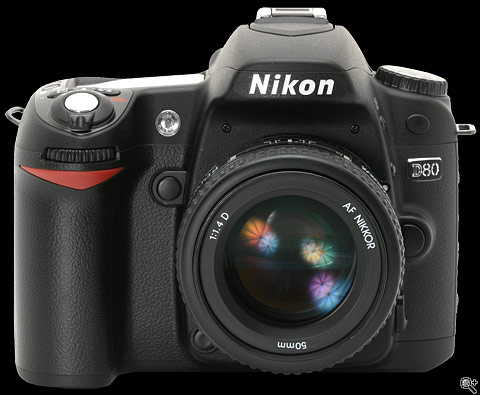
The modification consists of the removal of the low-pass filter which is a standard fitting for, I believe, Nikon and Canon digital SLRs in order to reduce moire patterns and to improve colour fidelity. Unfortunately, the low-pass filter also reduces the H-α wavelength received and will therefore make emission nebulae less visible. In place of the low-pass filter, a type 1a filter has been installed which is roughly the equivalent of a nebula filter, and since daylight is so much brighter - daytime photography should still be possible with some adjustment of the white balance. The camera was initially piggy-backed on the OTA of my SCT using a bracket from Astro-Engineering. I took a few photographs (that you can see on the Widefield page of this site) using a standard terrestrial 70-300mm Nikkor zoom lens but severe problems with focusing and chromatic aberration led me to abandon this and to purchase an apochromatic refractor (see above). It fits into the SCT Crayford focuser with a 2" adapter and a Nikon 'T' piece that provides the bayonet fit into the lens housing on the camera.
Accessories:
I found soon after pairing off the camera with the telescope that in order to begin taking decent photos, I needed a few more accessories. Most importantly, I needed a focal reducer. Used on the rear cell of the telescope directly, it increases the field of vision substantially, making it easier to frame an object of interest. Furthermore, increasing the field of view, although reducing the relative size of the observed object, increases the light intensity per pixel on the CCD making the image clearer and decreases exposure times. The focal reducer I use is only an f6.3 Meade 4000 series reducer and field-flattener which still allows visual observation - essential for me in order to centre the image. The f3.3 version cannot be used for direct visual purposes.
The second accessory which I have only recently acquired is an equatorial wedge for polar alignment of the telescope. Without it - any image exposure greater than about 350 seconds would begin to demonstrate rotational trails as the field of view rotates about the central axis during alt-azimuthal tracking. Although more fiddly and difficult to align when beginning an evening's observing, I found that this increased the exposure times I could set for photography and also increased the 'Goto' accuracy of the telescope.
Spring/Summer 2006
I have acquired the f3.3 focal reducer as well as the Meade series 4000 OIII filter and the broadband filter.
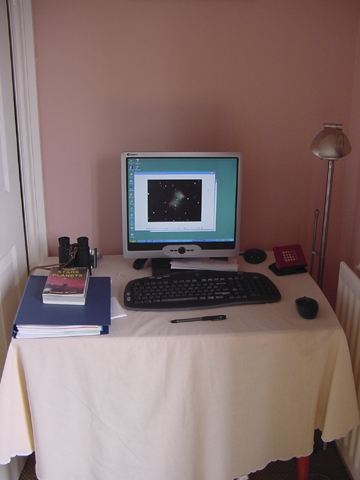
August 2007
On a visit to Cambridge, I took a drive to Dry Drayton to Green Witch. Came away poorer in monetary terms but richer in equipment - a Meade series 4000 ultra-widefield 14mm 1.25" objective lens, a Meade 25mm framing reticle eyepiece for CCDs, a Meade flipmirror which will also fit 2" eyepieces, and a Celestron Ultima 2x Barlow.
I purchased a William Optics III, 0.8x focal reducer and field flattener for use with the ZX66 refractor and my modified Nikon D80.
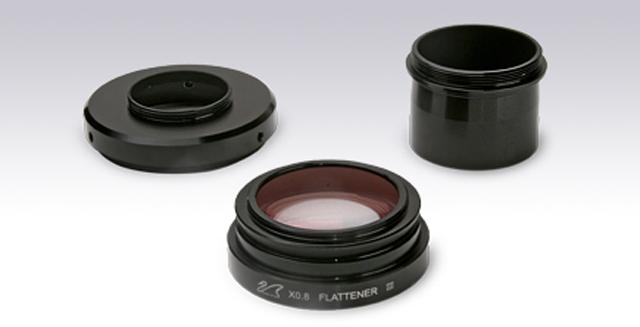
The three components consist of (from left to right) - the male T-ring screw for your camera adapter, the flattener/reducer lens, and the 2" SCT nosepiece. They come together to form a compact, if heavy attachment enabling you to slot your camera into a standard 2" SCT end. The united piece is shown below:
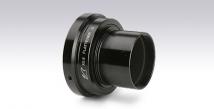
The Meade telescope shipped with Autostar Suite which I use for pointing. After alignment of the telescope, the comprehensive star charts in this software permit highly accurate object location at the click of a mouse through a serial cable link from a desktop pc (Windows XP Professional) to the telescope handheld computer, also called Autostar (confusingly). My software version is 3.18 and can be updated from the Meade website. Within the Autostar programme is a module which operates the DSI, called Envisage.
For processing of the raw image, I use 3 graphics programmes: Adobe Photoshop 7.0, Paint Shop Pro 7 and Maxim DL version 4.1.
I would ideally like to be able to run some of my images through a process of deconvolution (compensating for the point-spread-function of the CCD) which would reduce the 'bloom' which occurs around the stars in the raw image. MaximDL has 2 algorithms for deconvolution but before they can be applied, some variables unique to the CCD device need to be determined. The gain of each pixel or photoelectrons per ADU for my DSI is one such variable. Unfortunately, the manual which came with the DSI is sadly lacking in technical detail and it is also unavailable from the Meade website. A phone call to the Meade Help line resulted in a response of total bafflement from the support-staff. MaximDL has a wizard built into the programme which can work out this value from flat-field and bias frames and so, I'm going to have to do this in the near future to see if it will work.
Spring/Summer 2006
Through e-mails to the Meade Forum, I was contacted by Scott Roberts of Meade who inquired regarding the specifications described above from the engineers dealing with the DSI. He was informed that Sony, who make the CCD chip used in the DSI, do not provide them with this bit of information. Scott suggested asking the technical help from Cyanogen who make MaximDL to see if they had come across this situation with other DSI users. I haven't yet bothered, as hitherto, I've been trying to reduce 'star-bloat' by software means.
March 2007
I've learnt how to use Envisage and the DSI to autoguide the LX90 with surprising fidelity. Although autoguidance doesn't really take place whilst using the DSI as an imager because it can only guide in between exposures, I can still use the DSI to guide my new SLR camera. Furthermore, the latest release of Autostar 497 has added a Smart Drive option in the telescope setup menu - this allows the drive to be trained in Periodic-Error Correction (PEC) further increasing the accuracy of the RA drive.